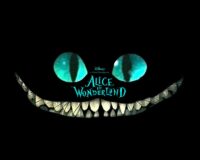Based upon the book “Car, Boy, Girl” by Gordon Buford, Herbie has paved his way into the film industry, and subsequently the hearts of audiences everywhere, ever since. The Love Bug was granted a limited release in 1968, with a more widespread release in 1969. It starred the legendary Dean Jones as racer Jim Douglas; Michele Lee as Carole Bennett, his love interest; Buddy Hackett as Tennessee Steinmetz, Jim’s best friend; and David Tomlinson as Peter Thorndyke, the film’s main villain.
Down on his luck, racer Jim is feeling hopeless and lost until he happens to be walking by an auto showroom in San Francisco. It’s there that he meets Herbie, and after Jim stands up for the little Volkswagen Beetle to the showroom’s testy owner, Peter Thorndyke, Herbie sets off after Jim. As Carole later puts it, Herbie thought Jim was “worth belonging to.”
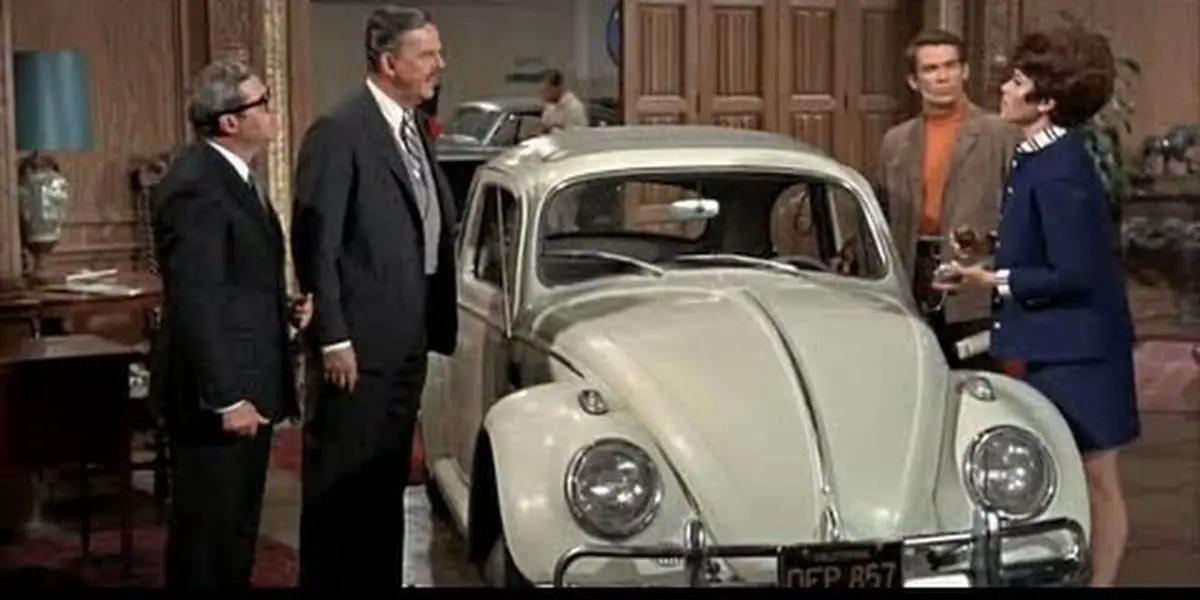
Herbie makes his way to Jim’s and Tennessee’s firehouse home, but it looks like grand theft. Luckily, Jim works out a deal with Thorndyke and becomes Herbie’s new owner. Though it’s not without its challenges, as Jim soon finds out on the freeway. One of my favorite lines in the film comes from a witness to the freeway event, “What’s the matter, you from LA or something?” As though LA drivers are more prone to strange driving than San Franciscans.
Instead of realizing Herbie is his own person, Jim believes Herbie’s actions are some kind of prank on the part of Thorndyke and Carole. He goes to confront them, and Carole agrees to accompany Jim, believing she has a responsibility to him as she sold him the car. They’re both taken off for a wild ride as Herbie keeps trying to pair the two together, much to their reluctance.
My favorite part of the entire film is when, during Jim’s and Carole’s test drive, the two end up at a restaurant, parked alongside two hippies. Herbie’s locked Carole inside, and she cries for help, saying she’s a prisoner and can’t get out. The hippie in the sunglasses (who is actually played by Dean Jones) responds that “We all prisoners, chicky baby. We all locked in.” I don’t know what it is about that remark, but it’s one of my favorite lines in movie history and never fails to make me laugh.
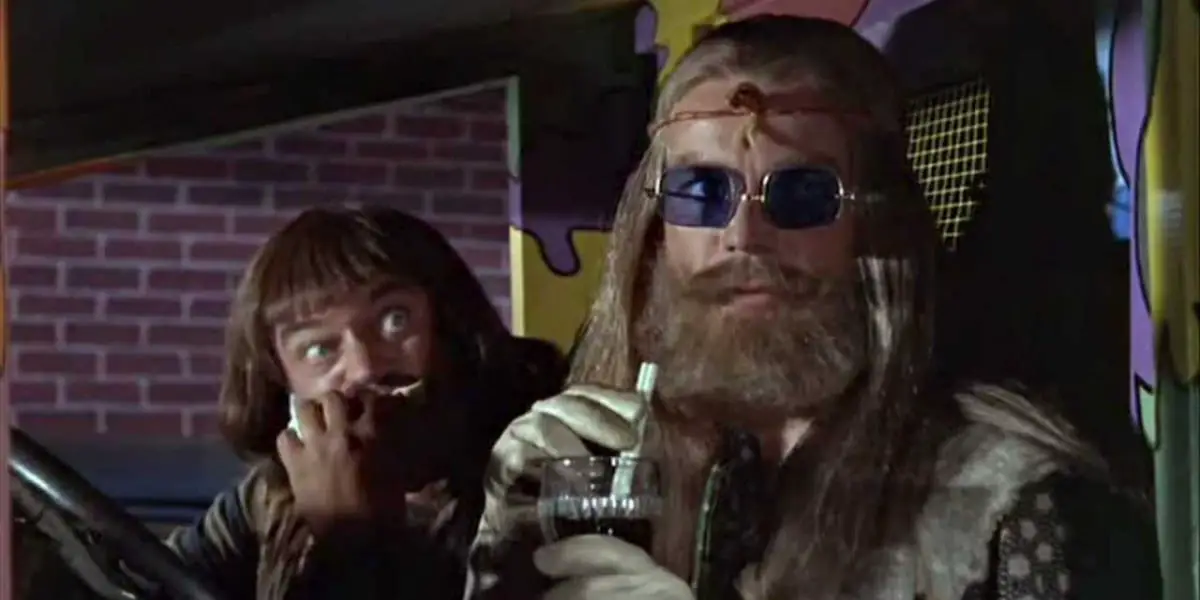
After this test drive, Jim’s changed his mind about Herbie after realizing the speed Herbie is capable of and signs up the little car to be a racer. The drive brought Jim and Carole closer together too, though the two were primarily frustrated with one another throughout the entirety of the drive.
Herbie’s races begin going incredibly well, a racing montage provided. Thorndyke gradually becomes obsessed with the little car, wondering what Jim’s done to modify it, while Jim’s ego inflates upon his many victories. Herbie’s paint job as a racer is one of the most recognizable: one large blue stripe, a white stripe in the center, and a red stripe beside it, going over the hood, ceiling and back of the car. A number 53 is painted on either door, in a circle. It gives Herbie a patriotic kind of look, something symbolic for Americans and giving off the kind of vibe that Herbie carries something good about him, giving audiences something to believe in. Or in Herbie’s case, someone.
All is going well until Thorndyke sabotages Herbie. While Carole and Tennessee bond over Herbie, with Tennessee clueing in Carole as to how special Herbie truly is, Jim resolves to start over and buys a brand new Lamborghini. Carole and Tennessee are hurt, betrayed on Herbie’s behalf. Herbie doesn’t take the purchase so well either, destroying the beautiful car significantly. It’s only as Jim attacks Herbie to stop him from destroying the Lamborghini that he realizes his foolishness, and takes a moment to reflect.
Jim realizes that Thorndyke, who had shown up to purchase Herbie, believes that Herbie is more than just a car alongside Carole and Tennessee. That’s when Tennessee points out that Herbie’s gone, as Herbie no longer believes in Jim. That’s when Jim takes off into the dark San Francisco streets to find his beloved car.
Though captured by Thorndyke’s men, Herbie manages to escape but goes to drastic measures by trying to commit suicide off the Golden Gate Bridge. Jim reaches Herbie in time to stop him, and Herbie ends up saving Jim in the end. In a way, they saved each other, which is the most touching moment of the film. Jim’s line to Herbie, “Come on, baby, it’s going to be a beautiful day tomorrow” is meaningful in more ways than one. It’s more than just looking forward to sunshine; it’s about how a new day means new beginnings and new starts, and it’s Jim’s way of saying he’ll be there for Herbie.
While Herbie was on the loose, he caused significant damage to Tang Wu’s (Benson Fong) store, but Jim is unable to pay for damages. With Tennessee’s help, Jim strikes a deal with Wu to enter Herbie into the El Dorado race. If he wins, Wu gets the prize money and has to sell Herbie back to Jim for a dollar, to which Wu agrees.
Unfortunately, Thorndyke is also in the race, and he’s not done causing trouble for Herbie just yet. Thorndyke conducts an oil spill, “made a pizza out of it!” regarding a spare tire according to Tennessee, and points Jim and the other racers in the wrong direction after switching signs. Thorndyke doesn’t exactly grasp the meaning of fair. Despite all this, Herbie still manages to return after the first leg of the race, albeit on two wheels and one makeshift one. Just when it looks like Herbie can’t make it through the second leg, Jim, Carole and Tennessee find out about the wager Wu had made with Thorndyke in which Thorndyke gets Herbie if he loses the race. Thorndyke comes to collect Herbie, and just when things look hopeless, everyone gets a surprise as Herbie finds an extra inner strength and comes to life, chasing after Thorndyke until Thorndyke leaps over a fence. No matter how bad a shape Herbie’s in, he finds the strength to “keep moving forward”, as Walt Disney would say.
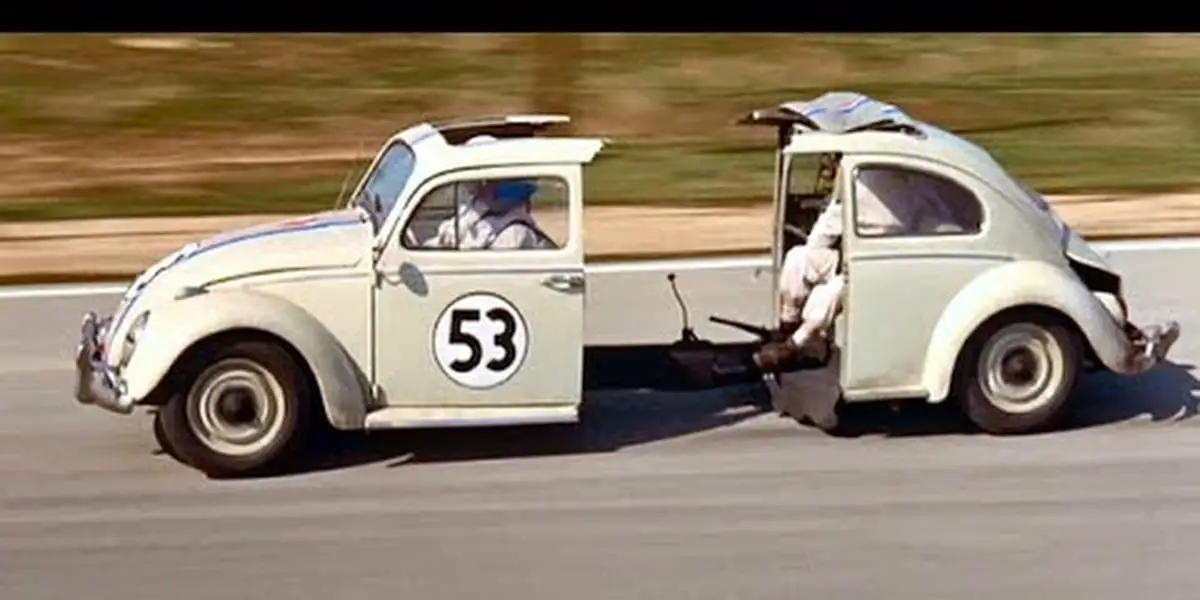
From then on things don’t get any easier, but Herbie and his trusty team make it through the obstacles anyhow, even when Herbie is split up, ultimately taking first, and third, place.
In true Disney fashion, we get the happy ending we expected all along. Thorndyke failed to read the terms of his agreement with Wu, and is now a mechanic in his prized auto showroom, which Wu now owns. Carole and Jim are newlyweds, with Herbie taking them on their honeymoon. Herbie truly earns his name as “The Love Bug”, a symbol of eternal and unconditional love in the eyes of audiences everywhere.
Promos
On March 23, 1969, Disneyland hosted a “Love Bug Day”, in which people everywhere were invited to decorate their Volkswagen Beetles and show them off. I think this is one of the most creative and fun promotions for a film to ever occur. It engages the audience and gets them to interact with the Volkswagen Beetle and the spirit of the movie itself. What better way to capture Herbie’s fun-loving personality?
According to the Disney Parks Blog, the cars were judged in categories of most psychedelic, toylike, comical and best personality. The winners were given a brand-new 1969 Volkswagen Beetle, presented by none other than Dean Jones and Michele Lee themselves. It’s certainly a high honor. Just being there that day and seeing all the creativity people had put into their Beetles would’ve been incredibly memorable and sensational to witness and be a part of.
Spiritualism
Tennessee is funny, but he’s also very serious when it comes to his spirituality. It comes from his time in Tibet. He’s the first to realize Herbie’s true identity, concluding that Herbie comes with a personality of his own. He tries in different ways to clue Jim in but doesn’t initially succeed.
Tennessee had an interesting point about man and machine:
“Jim, it’s happening right under our noses and we can’t see it. We take machines and we stuff ’em with information until they’re smarter than we are. Take a car. Most guys spread more love and time and money on their car in a week than they do on their wife and kids in a year. Pretty soon, you know what? The machine starts to think it is somebody.”
I love Tennessee’s character. He sees the world in a different way and provides many deep insights because of it. He doesn’t go along with everyone else and his belief in Herbie is unparalleled. Tennessee is a one-of-a-kind person, much like Herbie is a one-of-a-kind car. I think that’s why the two related to one another so well, and why the presence of spiritualism is so strong in the film.
The Villain
Peter Thorndyke clearly isn’t a nice guy. Yet, he’s the kind of villain that’s more comical in nature. In particular, his treatment of his right-hand-man, Havershaw (Joe Flynn). He’s constantly screaming at the poor fellow, and constantly requires Havershaw’s assistance in committing all his dirty tricks against Herbie and the gang.

Thorndyke usually gets some kind of karma along the way, however. Herbie, in one of his classic moves, leaks oil onto Thorndyke’s shoe, for instance. When Thorndyke puts Irish coffee into Herbie’s system, Herbie sputters out cream through his exhaust right into Thorndyke’s face as he’s receiving an award. Or, my personal favorite, the time he got trapped in Herbie and Carole opened the glove compartment to find his contorted face as he screamed at them.
In Disney movies, the bad guys lose. It’s one of the things we love about their movies. The villain tries so hard to win, but they’re always outdone by the good guys. The good guys carry an important message. Unfortunately in life, the good guys don’t always necessarily emerge victorious, but the fact that they’re good gets them a whole lot further in life.
Villains like Thorndyke, who are more bumbling and comical in nature, teach us to not take them so seriously. They teach us to be unafraid, to simply make a joke out of their heinous actions and to just keep being ourselves. Not all villains are as harmless, but the point is to not sweat the small stuff. They’ll get their karma, even if it’s not oil on their foot or cream in their face.
The Dark Aspect
One of the things that tends to be overlooked is the fact that Herbie tried to commit suicide. That’s a heartbreaking fact, so we’re always happy to see Jim show up to save Herbie from flying off the Golden Gate Bridge.
Suicide, especially in the 1960s, wasn’t exactly a widely-discussed topic. In that regard, that scene was ahead of its time. It’s also meaningful because all Herbie needed was to feel wanted, and needed. Jim being there for him when he needed it the most is what saved Herbie, and Herbie saved Jim in the same moment. They saved each other, and it speaks volumes in regards to their bond.
It’s a rare topic in Disney movies, so it’s definitely worth mentioning here. It was risky, but it works given the storyline and the overall meaning of Herbie being more human than machine. Like a person, Herbie has his emotions, too. One of my favorite articles talks about how Herbie helps the author with his depression and references the scene between Herbie and Jim on the bridge. It’s an inspiring story and definitely worth a read.
The Love Bug
Herbie is a symbol of love, unconditional and eternal love. It’s definitely one of the reasons why Herbie has had several sequels and has become such a major part of pop culture over the years. Herbie puts people together and brings out the best in them, teaching them lessons. He is there for them when they need him the most, as is the case with Jim Douglas. Herbie gives his owner something to believe in, and in the process, gets them to believe in themselves again.
The Love Bug is a good family movie because of its message of love. It’s a feel-good kind of plot that gets people to again believe in the good of humanity (or machine), and besides, it’d be pretty awesome if all our cars were anything like Herbie.
The Conclusion
The Love Bug has always been a special movie for my family. Just a few days ago, my uncle sent me a YouTube clip of Jim driving Herbie onto the freeway, ending with Herbie freaking out and driving off of it. Herbie comes up time and time again, and he’s the reason why I love Volkswagen Beetles so much. I’m planning on having a Herbie of my own one day.
As a kid, I loved cars. I memorized brands and models, created traffic jams out of my Hot Wheels collection. My brother was the same way. Naturally, our mom introduced us to any movie featuring cars, and The Love Bug was one of them.
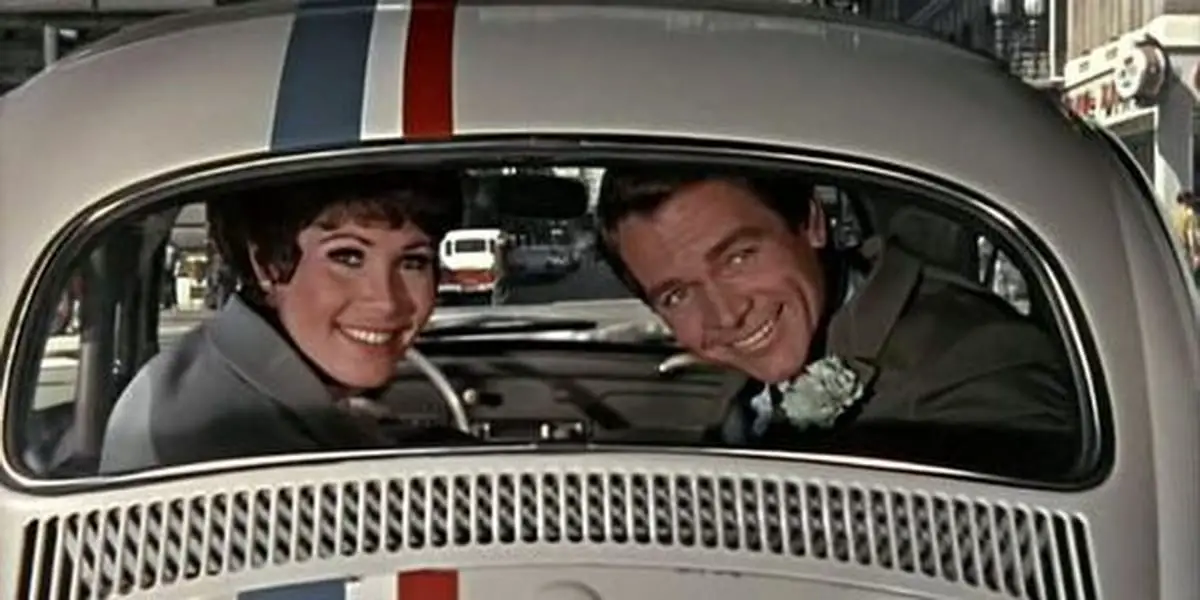
It’s one of my favorite childhood memories. I’ve seen the movie thousands of times but it never gets old. I still laugh and smile and have a great time with it. I admire Carole’s wardrobe (casual dress definitely had high standards in the 1960s), I love Herbie’s antics with oil and opening his doors by himself. I love that Herbie helps Jim, and I love that Herbie makes the impossible, possible (like skipping across water). Most of all, I love that Jim, Carole and Tennessee all come to believe in the little car and acknowledge that Herbie has not just a personality, but a heart, and that he brings them together.


